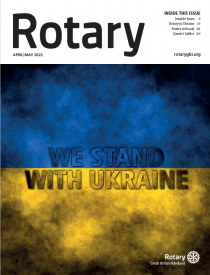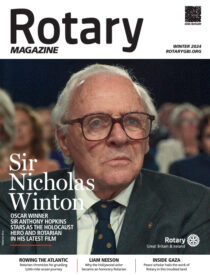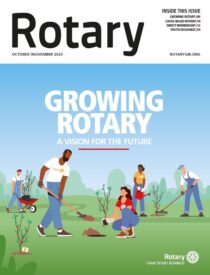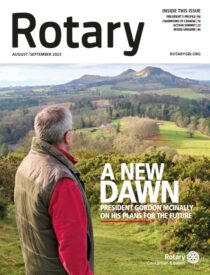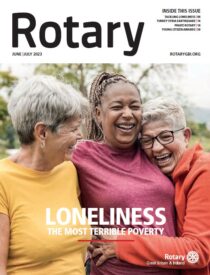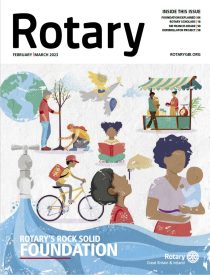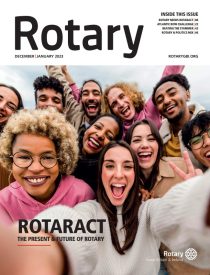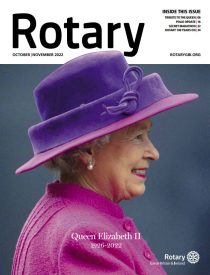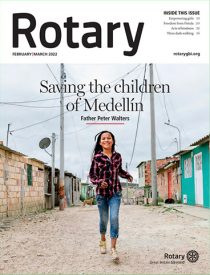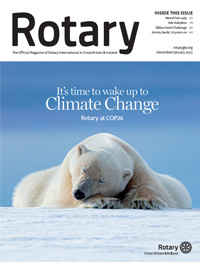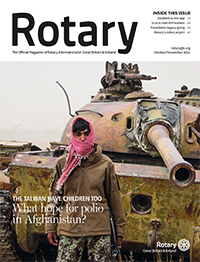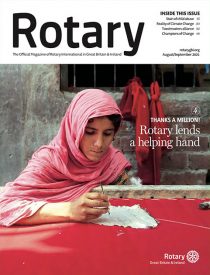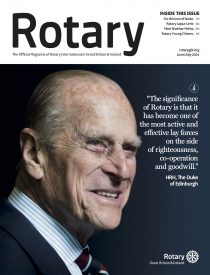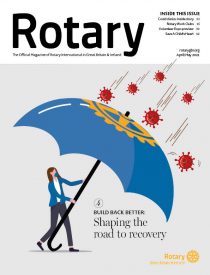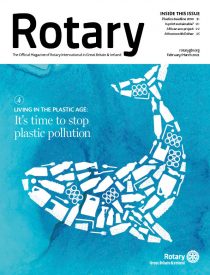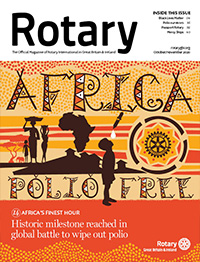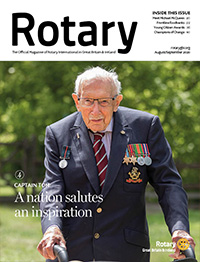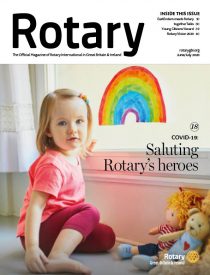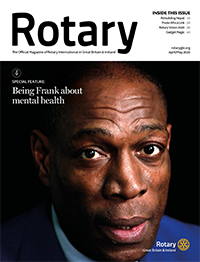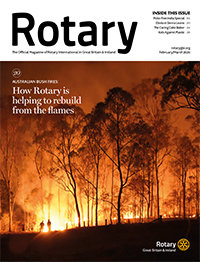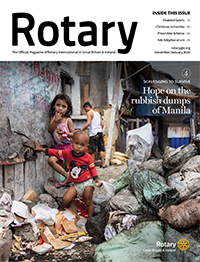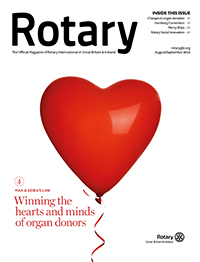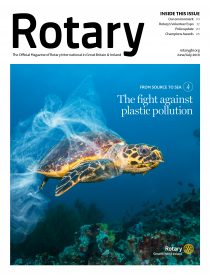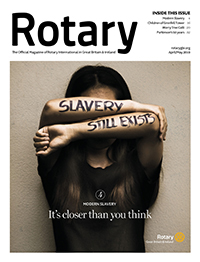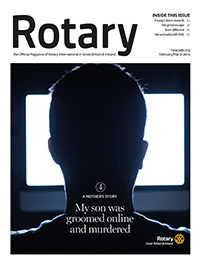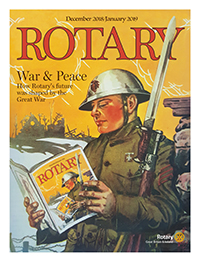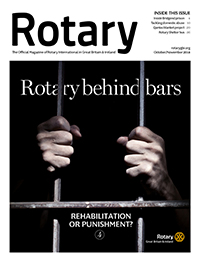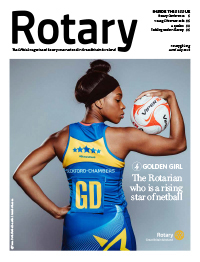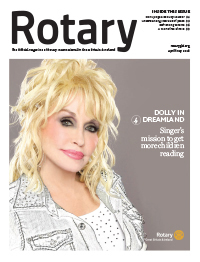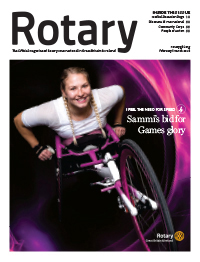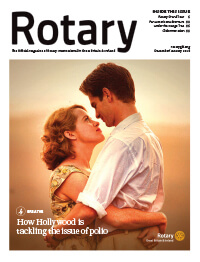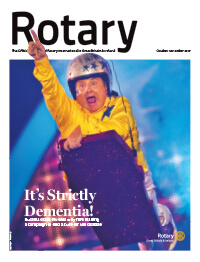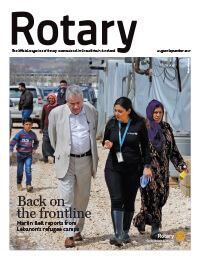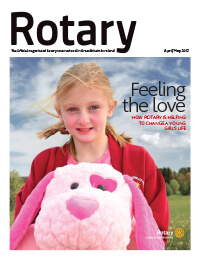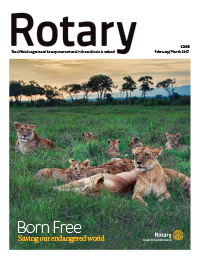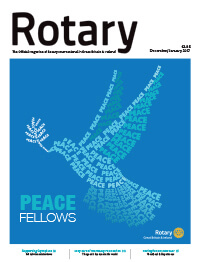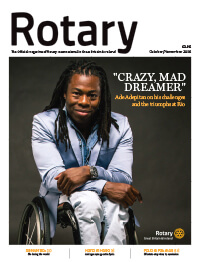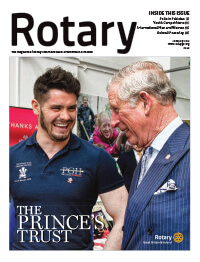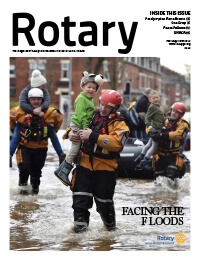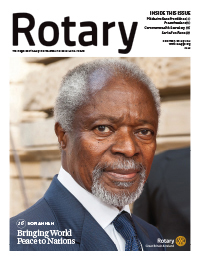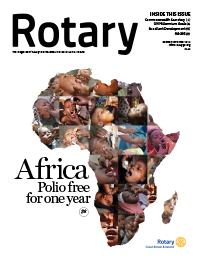Rotary President-elect Jennifer Jones’ office at Rotary International world headquarters in Evanston, Illinois, feels different from those of her predecessors, but that’s in no way a result of the fact that on July 1st she will become Rotary’s first female president.
On the wall hangs a recent gift from a friend — a black scratch-off map on which Jennifer can record every Rotary destination she visits during the next two years.
It’s September, two months since she took office as president-elect, and on the map, only Chicago has been revealed — many planned events were cancelled or postponed due to a rise in COVID-19 cases.
Listen to the audio version of Rotary Magazine
Today, Jennifer is the only person on the 18th floor of One Rotary Center. No phones are ringing, no fingers tap-tap-tapping on keyboards in the cubicles outside her door. One could do cartwheels through the Rotary boardroom and nobody would notice.
“If you start to think about how exponentially Rotary can touch the world, we’re more than a club,” Jennifer says. “We’re a movement.”
Jennifer is President and CEO of Media Street Productions Inc. in Windsor, Ontario, where she is a member of the Rotary Club of Windsor-Roseland. Husband, Nick Krayacich, is past president of the Rotary Club of LaSalle Centennial and was recently selected as governor-nominee-designate of District 6400. Her company’s specialities include radio and television production, corporate and nonprofit videos, and live show productions.
Using her media background to elevate Rotary’s global profile is one of the primary goals of her presidency, and Jennifer is planning what she calls the “Imagine Impact Tour” to showcase to the world several large-scale, sustainable projects in each of Rotary’s areas of focus.
Different is always better. Different is me”
“I see this as a way of increasing our membership,” she says. “When we tell our stories, like-minded people will want to join with us.”
A Rotary member since 1996, Jennifer played a lead role in the organisation’s rebranding effort by serving as chair of the Strengthening Rotary Advisory Group. She is co-chair of the End Polio Now Countdown to History Campaign Committee, which aims to raise $150 million for polio eradication efforts. She also led the successful #RotaryResponds virtual telethon in 2020, which raised critical funds for pandemic relief and attracted more than 65,000 views.
Between more serious topics such as elevating Rotary’s image and its efforts toward diversity, equity, and inclusion, the conversation jumps around to the retro appeal of the 1980s television show The Golden Girls, whose social commentary is relevant even today, Jennifer surmises, and dance parties – “Whenever a good song comes on, it’s hard to not get a little groove on,” she says.
Towards the end of the conversation, Jennifer’s dad chimes in with a ding on her phone and the one-word message, “passed” — he’s still working at almost 80-years-old and wanted to let her know he’d succeeded at an annual exam for his job.
“He is the sweetest thing,” she says with a smile. A few days earlier, his text to her had included a heart emoji and the query “How’s fixing the world coming along?” With the family of Rotary behind her, Jennifer is well on her way.
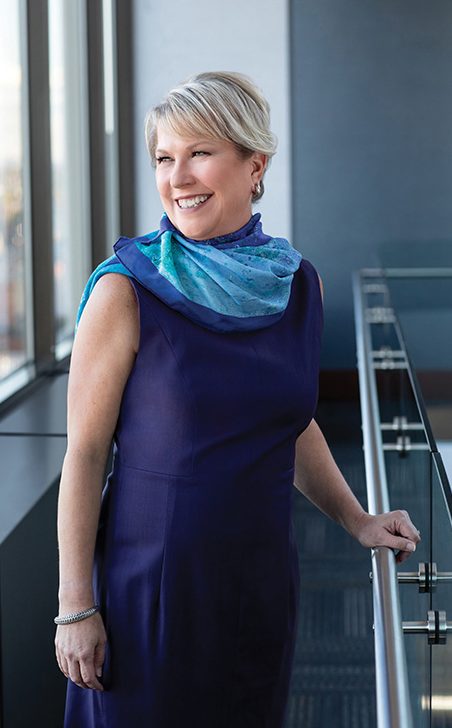

2022-23 Rotary International President Jennifer Jones. Rotary International World Headquarters, Evanston, Illinois, USA.
You’re going to be Rotary’s first female president. What does that mean for Rotary?
When I was selected, although the process was virtual, everybody went around the “room” to reflect on something that was said during the interview.
One of the points that were repeatedly emphasized was that I was selected for my qualifications, not because of my gender. I didn’t enter the interview with gender being at the forefront of my thinking.
However, I do think that for our organisation, it was an incredibly significant moment. Diversity, equity, and inclusion is so important not only for Rotary but for our world.
Maybe my nomination is happening at the right time. When I gave my acceptance speech at the 2021 virtual convention, I mentioned my 10-year-old niece during the opening.
She had given me a drawing of herself that included the words, “Different is always better. Different is me”. I loved it and was so proud of her for proclaiming this statement, so much so, that I ended the speech using her exact words.
Being different is nothing to apologise for.
One of our core values is diversity, and this is another way that diversity is represented. It’s just that it took 117 years for that to happen.
What does diversity mean for our organisation?
There is diversity in our Rotary world, but is there diversity in our own most immediate sphere, our own clubs?
When we have a diversity of thought, diversity of age, diversity of culture, diversity of gender, diversity of vocation, we bring that to the table. That is our secret sauce. That’s what allows us to solve things in ways that others can’t. We’re looking at it through that kaleidoscope of experience that we bring to the table.
There are going to be clubs that say, “No, we’re good. We’ve got diversity figured out.” And maybe they do and maybe they don’t.
But I think we are uniquely poised as an organisation at this time in history to be the honest brokers of these kinds of conversations.
Because we’re non-political and non-religious, we have the ability to host this type of dialogue and do it in a safe space where we respect each other.
How will you redefine the role of Rotary President?
I don’t know that I’m approaching the presidency from a perspective of change. I’m looking at it from the perspective of how we exist as a relevant organisation in today’s culture and climate.
How do we do things that are proactive and positive for our future?
Maybe it’s a bit of a shift in what we’ve been striving for over the past several years, in terms of reaching specific demographics.
Perhaps we need to walk it more authentically. If we’re going to ask more women to join our organisation and we’ve seen negligible results, perhaps this is an opportunity to inspire others to look forward and say, “If she can do it, so can I.”
If we’re looking for younger members and younger thinkers to be in our organisation, then we need to exhibit that behaviour. We need to showcase why it’s important to them — to make sure we’re giving people meaningful, intentional things to engage with in our organisation.
The biggest thing that I’m hoping I bring to the table is not gender but communication — how we communicate these things to our frontline members and others who are part of our family, to understand that being different right now is a good thing and that it doesn’t change who we are.
Our DNA remains true. Our core values stay true. Those are things that don’t go out of style. But can we look at things through a little bit of a different lens right now?
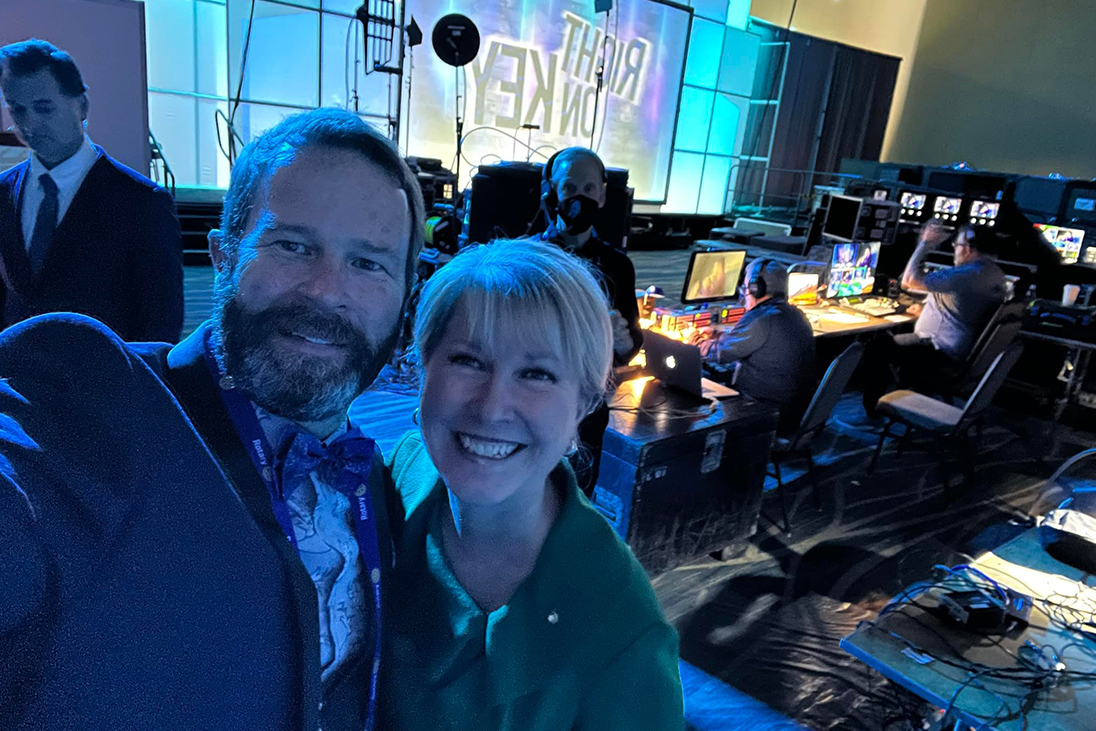

Jennifer at the Right on Key studio
You’re saying young thinkers as well as young members. What’s the distinction?
Have you met a 25-year-old who is old? We all have. Have you met an 86-year-old who is young? Of course. So I talk about young thinkers. It’s something that resonates regardless of where I am in the world. Embracing the fact that we are people of action speaks to our joie de vivre. We step out. We do things. That is what I think of in terms of young thinkers. We’re the people who make things happen in our world and our community.
We have such a brilliant opportunity to capture what I like to call cross-mentorship.
Sometimes a great idea comes through the lens of experience, and sometimes it comes from someone who hasn’t already been told that they can’t do something or that it needs to be done this certain way. When we look toward younger participants in our organisation, they give me hope that we can look at things through fresh eyes that we can constantly be in a state of evolution.
This is going to be a very wide generalisation: If you have a great new idea, and you give it to a Rotaract club, within days they figure out what it is that they’re going to do. They’ve launched some sort of social media presence.
They’ve called out and connected with partners. They’ve done all kinds of things. They take action really fast. Similarly, you can give it to a Rotary club, and what do we do? We form a committee and then we have meetings, lots of meetings.
That’s not to be dismissive of that more deliberate path; I say that very much in jest. But the bureaucracy sometimes can bring us to a slow stop and be frustrating for people.
There is an opportunity for us when we look toward the younger demographic.
They just do things differently. And I think that’s something we truly can learn from them.
You’re a natural storyteller. What’s the first sentence of the opening chapter of your presidency?
It’s one word: imagine.
That’s your theme, right?
Imagine Rotary.
How did you come up with that?
Imagine to me is about dreams and the obligation to run after those dreams.
I want people to think about the things that they want to achieve, and then use Rotary as the vehicle to get there.
We have such a huge array of opportunities in front of us, but we need to channel our energies so that we make sustainable, impactful decisions about what we do.
The most powerful thing for a member is to be able to say, “I have an idea.” And then to share that with others and to amplify it and figure out where to go with it. Imagine is an empowering word, giving people permission to say that they want to do something to make their world better, and they can do it because they’re part of this family.
What is contemporary leadership, and how does your style of leadership fit in?
The past two years have given us this deep opportunity to take a look at what’s important to us and what things we want to get rid of, that carry too much baggage in our head and on our shoulders.
Now we can look forward to how to do things a little bit differently and, probably most important, more authentically.
How do we be true and honest to ourselves about what we want to spend our time doing, whom we want to spend our time with, and how we can work toward supporting each other better, not just as friends and neighbours but as humanity?
From a contemporary leadership perspective, we need to take the best from the worst. We’ve watched world leaders broadcasting from their kitchens and from their basements.
We have learned how to be different and more appreciative of other people’s experiences. As Rotary, that’s what we’ve been good at all along. This is our time to shine.
I’m proud of being a connector. I like to connect people, and I like to connect people to stories. I’d like to see how that can be harnessed.”
What strengths and weaknesses do you bring to the presidency?
I’m proud of being a connector. I like to connect people, and I like to connect people to stories. I’d like to see how that can be harnessed. I think my strength is also in communication and looking at how we can do things just a little bit differently. The most important thing that we can do is make sure that every member of our organisation understands what it is to be part of it.
There are many different ways to communicate that, and it’s not just about sending an email. It’s about creating a reason for people to want to hear from the organisation.
One of the things I want to do is go live directly following a board meeting.
I want to tell people what their organisation is doing — what just literally happened. Breaking news from the 18th floor in Evanston, and here is what it means to your club experience. Can we tell that story? I want to use some of the newer tools; when I’m travelling in the field, I will have my little GoPro camera.
I want to field-produce my own presidency. I want to showcase what I just saw and what this person just said to me.
A weakness? Balance. Trying to take care of myself — trying to eat right, exercise, make time for friends and family. I’m not always good at it.
I think this harks back to the conversation we’re having about the pandemic. We’ve all had this opportunity to push the pause button. Sometimes we go a thousand percent toward something that we’re working on when that’s maybe not the right approach. We can be stronger when we’re better to ourselves.
I think we’ve really learned this; at least I have.
One of the things that I have taken pride in my entire life is not dropping balls. I’ve arrived at a place where there is a lot going on, and at the same time, I’ve given myself permission to drop some balls. There are so many different ways that people now communicate, whether through email, text, WhatsApp, Facebook, LinkedIn, or Twitter. I’ve got two phones going. It’s crazy. So I have given myself permission to walk away and to not be tethered to my phone.
I’m aware of it, I am respectful of it, but I need to be a little bit more present. I could literally be communicating 24 hours a day. And that doesn’t serve anyone.
You are well known for being a hugger. So what’s the new hug?
That’s a tough one. Elbow bumps are definitely going to be a pattern going forward, maybe a fist bump here or there. Hugs are probably on hold for a little while.








